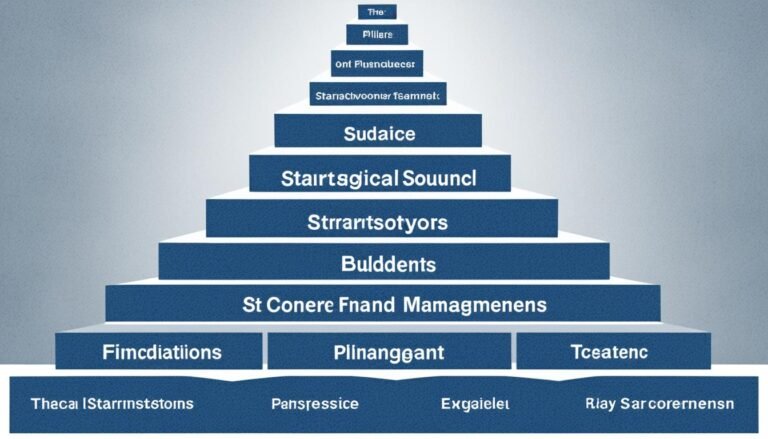A Guide to Solvency II Compliance for Irish Insurers
Many might not know this, but since January 1, 2016, Solvency II has been a crucial guide for insurance companies. It focuses on non-life, life, and reinsurance. Its goal is to keep policyholders safe by ensuring insurers have enough money to cover risks. They need to meet strict financial requirements like the Minimum Capital Requirement (MCR) and the Solvency Capital Requirement (SCR).
Irish insurers must follow financial services legislation. This includes rules from the Central Bank of Ireland (CBI). The CBI guides insurers in showing they stick to laws and good corporate practices. The Insurance Acts and Corporate Governance Requirements for Insurance Undertakings 2015 are vital for their operations.
This guide will help Irish insurers understand and meet Solvency II rules. It aims to give them the tools to deal with this important part of their business.
Key Takeaways
- Solvency II has been effective since January 1, 2016, for non-life, life, and reinsurance companies.
- Insurance companies must meet MCR and SCR to shield policyholders from excessive risk.
- Regular Own Risk and Solvency Assessment (ORSA) are necessary to evaluate risk profiles.
- Adequate governance systems are a mandate under Solvency II.
- CBI guidelines emphasize the significance of compliance statements and directors’ certifications.
Understanding Solvency II: An Overview
The European insurance market uses the Solvency II Directive for stability. It sets rules for insurance companies to keep their finances strong. Solvency II helps by looking at the rules for money, how companies are run, and how well they tell the truth about their money.
What is Solvency II?
This is a big deal in the world of insurance. It makes sure all insurance companies in Europe follow the same rules. Its goal is to manage risks well. This helps make sure insurance companies have enough money to pay out claims. That way, customers are protected.
The Directive started in 2016. It’s there to keep insurance companies strong, protecting the people that buy their policies.
Key Objectives of Solvency II
Solvency II wants to make sure insurance companies are strong for their customers. Its key goals are to:
- Increased Policyholder Protection: Keep insurance companies strong to protect customers during hard times.
- Market Consistency: Look at what things are really worth to make financial reports clear and reliable.
- Risk-Based Approach: The higher the risk, the more money insurance companies must keep. This helps manage risks better.
- Improved Supervision: Leaders make sure companies follow the rules well, including across different European countries.
History and Development of Solvency II
The path to Solvency II started with a plan in 2009, called Directive 2009/138/EC. This plan aimed to make European insurance rules easier to follow. In 2016, the new rules became formal, affecting many important parts:
- Level 1: The basic rules from Directive 2009/138/EC.
- Level 2: Detailed rules from Delegated Regulation and Implementing Technical Standards (EU) 2015/35.
- Level 3: Extra advice and practices from EIOPA for supervision.
New rules have been added to Solvency II over the years. For example, changes from Directive 2014/51/EU and new Delegated Regulations in 2015. One interesting change was that inflation led to lower estimated costs for insurance companies. This shows that Solvency II is always improving to meet new challenges.
The Legal Framework of Solvency II in Ireland
Ireland follows strong laws for Solvency II. The regulations from 2015 connect with EU rules. They make sure insurance companies in Ireland follow both local and EU laws.
Ireland’s insurance market is stable because of these laws. Since 2016, Solvency II rules have reduced the impact of insurance problems. Cases like Qudos and Gefion show Irish laws work well.
Life insurers in Ireland must have at least €3.7 million in capital. It’s €2.5 million for non-life insurers. However, that can rise to €3.7 million in some cases. Reinsurers need €3.6 million, but captive insurers only need €1.2 million. The capital must be 25% to 45% of the total needed, keeping things fair.
The Central Bank of Ireland keeps a close eye on insurance companies. It wants to know about big business moves. This includes new products, growing into new areas, or changing reinsurance.
Insurance Ireland is key, with over 130 members helping the economy. They pay a lot in taxes and protect billions in savings. This group covers most Irish insurance firms and serves 25 million people worldwide.
Irish insurers get special rights under Solvency II in the EEA. But they must work to avoid being just a shell company post-Brexit. The rules aim to keep a strong insurance sector in Ireland.
Risk Management Requirements Under Solvency II
Irish insurers must have detailed risk management in place. This includes checking both obvious and hidden dangers. They use special methods to deal with risks and make sure everything runs smoothly.
The rules they follow come from the European Insurance and Occupational Pensions Authority. Also, they must obey Ireland’s own laws, such as the Finance (Miscellaneous Provisions) Act 2015. These rules keep their work consistent and strong.
Risk Identification and Assessment
For a risk policy to be good, it must spot and measure dangers well. The Central Bank of Ireland uses PRISM to watch over insurers. This ensures risks are found and understood.
Thanks to PRISM, insurance companies can be ready for anything. They become stronger in the face of tough times.
Quantitative and Qualitative Risk Management
Dealing with risk in numbers and figures is part of risk management. It means using math to know exactly how risky things are. The Central Bank sets rules on how much money insurers must have to be safe.
On the other side, there’s managing risks about how a company is run. Are the bosses doing their job well? Do employees know how to keep risks low? This checks that everyone is following the right rules.
Internal Control Systems
Good risk management starts on the inside. A well-organized system for checking and fixing risks is critical. The Central Bank says how this should be done to stay safe.
Keeping a close eye on risks helps insurers stay strong, even when doing business in other countries. This shows they are keeping up with the latest rules and are trustworthy.
Capital Requirements for Irish Insurers
Insurance firms in Ireland set up their financial solvency based on the Solvency II Directive. It has been in place since January 1, 2016. This rule makes sure that insurers have enough money to pay their policyholders when needed.
Minimum Capital Requirement (MCR)
The Minimum Capital Requirement (MCR) is key to meeting legal capital standards under Solvency II. In Ireland, this amount can be between €2.5 million and €3.6 million, based on the insurance license type. Companies have to keep at least this amount available to cover their debts if they close down.
The Central Bank of Ireland looks after those firms dealing in non-life insurance. It asks them to follow these rules for keeping their operational permits. In addition to the MCR, insurers need to hold extra money above 100% of their SCR as a safety net.
Solvency Capital Requirement (SCR)
The Solvency Capital Requirement (SCR) is the amount needed to survive major losses over the next year. It’s vital for checking how financially healthy insurers are. The SCR covers all known risks. This ensures policyholders will get paid, even in tough times.
The Central Bank of Ireland has the power to watch over insurance companies. It can ask for data, do checks, and step in if needed. This strong oversight keeps Ireland’s insurance world strong and reliable.
Methods for Calculating Capital Requirements
Figuring out how much capital is needed under Solvency II uses advanced techniques. These methods are designed to promote a firm’s strong financial health. The main ways include the Standard Formula, Internal Model, and Combination Model.
- Standard Formula: It’s a set model from EIOPA. It figures out the capital needed based on certain factors.
- Internal Model: Insurance companies can design their model for more accurate risk assessment. It has to be approved by the Central Bank.
- Combination Model: This uses parts of the Standard and Internal Models to address different risks.
Using these approaches ensures that insurers meet the capital standards. This makes Ireland’s insurance market financially sound and dependable.
Governance and Organizational Structure
Under Solvency II, Irish insurers need strong governance. This means being careful about managing how they follow rules and lead. They must clearly say what the board does, how key roles work, and make good choices. This helps a company work well and be honest.
Board Responsibilities
The board has the main job of deciding how to lead and follow rules in a company. They must give clear goals, keep things open, and protect everyone involved. They focus on:
- Making sure the company follows Governance Rules from 2015
- Picking who does what, like Non-Executive Directors
- Checking if people are really independent based on their money, job history, and connections to the company
Role of Key Functions
Inside an insurance company, certain roles are vital for keeping things working and following rules. This includes:
- Checking inside the company to make sure everything’s done right (Internal audit)
- Managing and lowering risks (Risk management)
- Making sure the company follows laws and rules (Compliance)
- Dealing with the financial side, like making predictions about the future (Actuarial functions)
Each role has to work on its own so they don’t mix up interests. They all help keep an eye on how well the company obeys rules.
Effective Decision-Making Processes
Being good at making decisions is crucial for a company to work smoothly. It’s about using different ways to look at and handle risks now and in the long term. This includes dealing with sustainability and climate change challenges. Companies need to face and manage these risks in how they invest and sell their products, following the newer rules of Solvency II.
Setting up strong governance rules means companies can deal with following rules better. It helps them avoid big problems and makes them more open and responsible.
Reporting Obligations and Disclosures
The Central Bank of Ireland (CBoI) sets strict rules for insurers. They must report and disclose financial health. Insurers use reports like the SFCR, RSR, and ORSA. These show their risk management, solvency, and financial state.
The CBoI uses PRISM for oversight. It helps look at both data and how well insurers manage risks. Starting in 2023, insurers must also focus on sustainability risks. This shows why they need strong risk management and good financial reports.
From January 2023, the IFRS 17 standard makes financial statements clearer. The Climate Change Unit started in 2021 also plays a big role. Insurers must update their rules to meet new standards. Good and on-time regulatory reports help keep the market stable and protect clients.
Source Links
- Insurance Business – Brexit – An Irish Guide
- Regulator sets expectations on Irish insurers’ outsourcing arrangements
- Navigating Solvency II reforms: Achieving 2025 compliance | CCH Tagetik
- Reporting Requirements for Solvency II
- Solvency II
- The change agenda for Irish (re)insurers: 12 areas of focus over the next 12 months
- Insurance & Reinsurance in Ireland
- What Irish insurers should consider when establishing a ‘third country’ presence
- No title found
- Extreme Event Risk Management Consulting Services
- Solvency II: the EU regulatory regime for insurers
- Q&A: insurance & reinsurance regulation in Ireland
- Capital management activities by Irish (re)insurers
- ESG Insurance Regulatory Guide: Risk Management under Solvency II | DLA Piper
- Guidance for (Re)insurance Undertakings on Intragroup Transactions and Exposures
- No title found
- ESG Insurance Regulatory Guide: Risk Management under Solvency II | DLA Piper
- Microsoft Word – A Guide to Non-Life Assurance Regulation in Ireland








